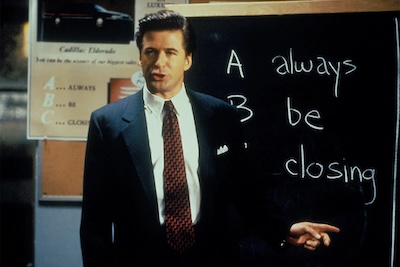There was a time in the late ’60s and into the ‘70s when horror films played at a higher level. I’m speaking of Rosemary’s Baby, The Exorcist, Carrie, and John Carpenter’s Halloween. Halloween established a very particular technique that Carpenter mastered: the stalker’s-eye-view. Under the skilled control of Carpenter, that technique enhanced the anxiety of what you felt on screen before anything happened to any given victim. This method went on to be perverted by various horror films of the late ‘70s and ‘80s. Far too often, the use of the “stalker’s-eye-view” was for the purpose of titillation. Think of all the shower and skinny-dipping scenes that followed (I’m looking at you, Friday the 13th). The purpose of the killer’s viewpoint was no longer to create the sense of unease that comes from thinking you are safe when you are not. It was used to show a young, fit, nubile female in her birthday suit right before she gets the knife.
The misogyny in these scenes was rampant. The girl gets naked and then gets killed for it. The implication that she’s a whore and deserving of a brutal death might have been easy to miss at first, but after the 100th time, it starts to take hold, even for those slow on the uptake. If you think about all those horror films from the ‘80s that took Carpenter’s groundbreaking work and slapddashed it down for the lowest common denominator–and lord knows there were countless films that fit the bill—they all had one thing in common: They were made for men that couldn’t get the pretty girls, but got to see their naughty bits before they “got” what was coming to them. Incel wasn’t a term anyone was using in the ‘80s, but it’s not hard to trace its origins to the age of the slasher flick.
What makes director Jason Zink’s ultra-low budget horror film Looky-loo so interesting is how he takes the stalker’s view and runs with it the entire movie, but with a purpose. There is no moment when we see a viewpoint that isn’t from the killer’s eye. Set in the Midwest, in decidedly mundane neighborhoods that could be Anywhere, USA, or at least any city with four seasons, the homes in Looky-loo are modest, but not crummy. Grass grows over the sidewalks, most of the garages are single-car, and all the homes look to be about one thousand square feet. Everything about these neighborhoods is decidedly normal.
Look-loo is decidedly patient before any killing takes place. We see the faceless protagonist approach multiple homes, looking under doormats and porch trinkets that might have a spare key placed there (among other things, the film is great inspiration for being more creative about your spare key hiding place). The fact that he does so in broad daylight adds to the anxiety. How often do we see something questionable in our neighborhood and dismiss it as an overreaction? I must confess, I’ve been guilty of such. Unfortunately, the killer’s persistence pays off. He finds a handful of keys, takes them to his local hardware store, creates copies, and returns the originals. Weirdly, it’s almost polite.

The hunter’s prey is single women. At first, he cases their homes by day while they are away, and in the evening, after they come home from work, peeking through windows and learning their routines. Eventually, he takes the final step of entering their homes, hiding in closets, and waiting for the women to relax into their early to late evenings. They wash their dishes, prepare for bed, and watch a movie with their boyfriend, all under a false sense of security. Looky-loo makes the interesting choice to create no fulsome characters. We never see the face of the killer, not even in a mirror, and his female targets are not given arcs or storylines. Zink’s decision to eschew conventional character development opens up the film to criticism that the women are mere objects, but taken as a film seen entirely from the perspective of the killer, the choice makes sense. These aren’t women to him. They aren’t even human. They are objects. While he’s wandering through their homes, we pick up little pieces of the victims’ personal lives. Family photos, posters on the wall, and style choices are evident, but we never learn their names, what they do for a living, or what they may want to do with the rest of their lives, but we never forget that they deserve to have lives. The killer has no interest in them beyond what he wants to do to them, but we have interest in them. In their normalcy. There is a sequence where one of the young women puts knee-socks on before going to bed. That’s a very midwestern move if your feet get cold easy. In the winter, my wife will do the same. Watching that sequence chilled me to the bone.
For the most part, the murders in Looky-loo are not terribly gory by the standards of the average horror film. The bloodshed is not excessive, and while the killings are terrifying, they are not rendered gratuitously. Looky-loo is not interested in giving you a good time. In no moment is this more obvious than in the final murder of the movie, which is extended, and the protracted nature is genuinely painful. Despite not knowing many details about the victims, what we do understand is that these are women who are doing nothing more than going about their lives with the belief that there is no wolf outside the door.
That’s what makes Looky-loo so disconcerting. From the beginning of time, women have had to look at the world in a much different way than men. When they leave home and return home, their lives exist on a greater level of risk. One of the few aspects we learn about the killer is that he has a prudish streak. At one point, he’s in a woman’s home while she’s taking a shower, but he does not linger. As she sleeps, her thigh is exposed, and he covers her up with the displaced edge of the blanket. He has a female mannequin in his home, which he dresses discreetly. It doesn’t take a genius to figure out that this man is incapable of having a relationship with a real woman. He’s an incel, and the very idea of sex is a threat to him. As much as the women in the film fear him when they encounter him, it’s clear he’s scared of all women. I’m willing to bet he would struggle to order a coffee from a female barista.
We may never see the face of the killer, but I’m sure most, if not all of us, have met someone like this. We may not choose to spend time with such a person (and if you are, please reassess your life), but we’ve recognized the type, and those of us who are sane walk away slowly. But what if walking away is not where it ends? What if you, as a woman, minding your own business, being reasonably careful, and just trying to get through your life, become the focus of the deranged? There’s no planning your day around that. In its own unique way, Looky-loo is a very feminist statement. I did not expect to write that line when I watched Zink’s film, but denying any other conclusion is a heavy lift. Women live in a different world than men, but men of ill repute can invade their world anytime. At no point in my life as a man have I ever considered such dangers.
There will be a part two to Looky-loo. Until then, you can find the first film on Blu-ray and VHS. The filmmakers are currently negotiating with streaming services for a wider release. I hope they get it.









